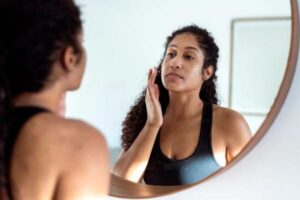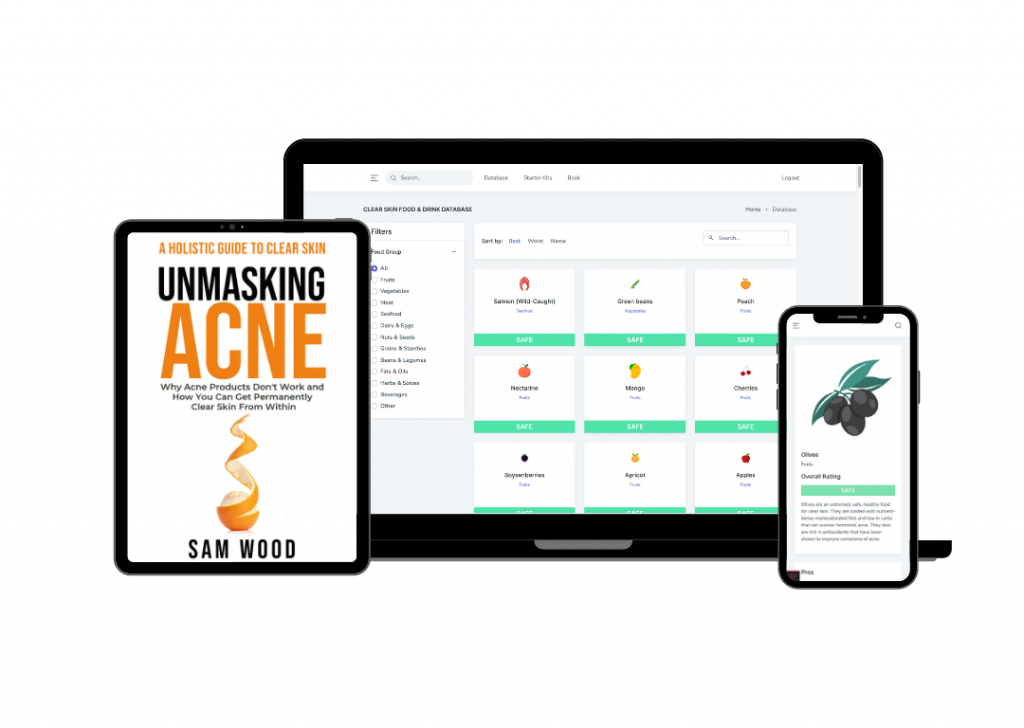What Causes Acne Before Your Period?
I’m sure many of us know that a ‘period’ is the breakdown and loss of the uterine lining, which occurs monthly if an egg is not fertilized. The entire menstrual cycle is controlled by four main hormones – LH, FSH, estrogen and progesterone. Throughout the month, they rise and fall, which triggers different key moments – like the release of the egg, or the breakdown of the uterine lining. A graph is inserted below showing how these hormones vary.
(Image reference from Menstrual Cycle Hormones | New Health Advisor)
As you can see about a week before menstruation the level of progesterone peaks. Throughout menstruation LH and FSH are at their lowest levels, and both progesterone and estrogen levels drop. So, how do these hormones impact the skin?
The sharp rise of progesterone levels triggers sebaceous glands to produce more sebum, which is the culprit for increased pimple formation. The hormones can also cause the skin to swell slightly, which means the pores are compressed making them become congested much more easily (meaning more blackheads!) This extra sebum also enables bacteria colonies to thrive – leading to dysbiosis, which is when the levels of bad bacteria to good bacteria are not balanced, meaning the acne can spread more easily.
To add to these hormones testosterone also impacts the skin, which is renowned for increasing sebum production further.
Best Dietary Guidelines To Prevent Acne During Menstruation
Dietary guidelines often follow a two-prong approach, firstly increasing nutrition through supplementation, and secondly decreasing the amounts of inflammatory food and drinks.
When supplementing the skin, there are many ingredients which are specifically helpful for controlling acne as outlined below:
- Zinc: Zinc is one of the best supplements you can take for acne management (and it’s often found in topical skincare!) Zinc has many impacts on the body such as reducing bacterial populations, acting as an antioxidant and also reducing the risk of insulin resistance. The importance of maintaining good insulin levels can be found HERE
- Selenium: An antioxidant, regulates inflammation as well as thyroid hormones.
- Chromium: Helps to balance blood sugar levels by regulating insulin
- Magnesium: Lowers inflammation and balances hormones.
- Turmeric: Great for reducing inflammation, as well as being an antioxidant
- DIM: Lowers, and balances the levels of estrogen. This is especially helpful for people who struggle with conditions like PCOS and Endometriosis (like myself!) I highly recommend reading up on this more.
- Dandelion Root : This helps to improve the detoxification processes within the liver, which aid in the removal of hormones such as testosterone. This reduces the buildup of sebum.
- Probiotics: Help to improve the population of good bacteria within the gut, which helps to improve skin health via the gut-skin axis. This supplement helps to address dysbiosis.
Amending your diet may help reduce hormonal acne with dairy, alcohol and certain carbohydrates being a good place to start. However I’m well aware this is easier said than done when you are craving a big bowl of ice cream! Some simple swaps, and the how this may help your skin is outlined below:
Cow’s milk → Plant based milk (I love hazelnut!)
- This helps as dairy produce can trigger more sebum production, as well as inflammation. Not all plant based milks are created equally, as some will have a greater insulin response, or contain phytoestrogens which can make hormonal acne worse. To help you choose the best plant based milk for you, check out this guide.
Caffeine → caffeine-free options (or just cutting down)
- Caffeine can increase the production of androgen hormones, which includes testosterone. As we’ve previously mentioned, testosterone increases oil production within the skin, and more oil increases the risk of pores clogging and forming pimples.
Alcohol → Alcohol-free options (again, just cutting down helps)
- Alcohol can affect the skin in many ways; dehydration, sleep disruption, insulin-spikes if the drink is sugary, testosterone production increased or potential liver damage if consumption is continually over the limit
What is the Difference Between Premenstrual Acne vs. Regular Acne
Regular acne is very much multifaceted, meaning there are many factors which contribute to pimple formation. Factors include genetics, hormones, medication, diet, stressful lifestyle, cosmetic products – and that’s just a few!
Premenstrual acne is much more dependent on hormones, which can be identified if your acne has a clearer pattern, with your acne flare ups occurring at a similar time every single month! This is due to the characteristic pattern of hormones rising and falling – as shown on the graph at the start of this article.
Will Birth Control Help Manage Breakouts During My Period?
This is such a hard question to answer, as birth control methods widely vary. Obviously, physical barrier methods like condoms will have no impact on monthly hormonal fluctuations (except for preventing those future pregnancy hormones!)
Other methods of birth control include : the contraceptive implant, the intrauterine device, contraceptive injection or the multiple types of birth control pills. Each type is outlined below, with its impact on acne.
The contraceptive implant – A flexible rod placed under the skin in the arm, which releases progesterone continuously. This prevents the release of the egg every month. The progesterone increases the production of sebum, meaning pimples are more likely to form. Acne, or acne worsening is a side effect of this medication
The intrauterine device – This is also known as the coil, which does not release hormones. It alters cervical mucus to prevent pregnancy. As it does not release hormones it won’t impact acne very much!
The contraceptive injection – This injection causes progesterone to be released into the bloodstream, similarly to the implant. This also means that acne is likely to worsen due to the effects of progesterone on the skin.
Birth control pills – consist of two main types, either progesterone only (having similar side effects as the injection or implant) or the combined pill. The combined pill consists of both estrogen and progesterone, with the estrogen thought to be the important factor for controlling acne. This helps to alter the ratio of estrogen to androgen hormones within the body, meaning the androgens have less impact – hence don’t affect the sebum production as much as before. This means sebum is produced in smaller quantities, and pimples form less frequently.
This impact of estrogen compared to androgenic hormones like testosterone explain why more males experience acne throughout puberty compared to females.
Will Accutane Control Help Manage Breakouts During My Period?
Accutane is a prescription-only treatment, which you have to go to an appointment with a dermatologist to be considered for. It is a very strong medication, so it has to be carefully considered – and you must use two types of birth control whilst taking the medication.
Accutane works to greatly decrease sebum production, meaning pores are very unlikely to clog. This is a more dramatic version of the effect seen by using the combined birth control pill. Based upon this observation, accutane is likely to help premenstrual acne, as premenstrual acne is caused by the rise in progesterone (and its effect to increase sebum production.) and accutane will counteract this.
Another prescription-only treatment that works really well for some people with hormonal acne is spironolactone, which is an anti-androgen. This means the effect of androgenic hormones will be lessened, hence oil production is kept in check much more – hence less chance for pimple formation!
Skincare Routine to Prevent Acne During Menstruation
As we have identified that premenstrual acne is caused by the overproduction of sebum, and hence clogging pores, we must focus treatment on helping to unclog pores. Treatment types are outlined below
- Topical retinoids: These are vitamin A derivatives, which can be found in many strengths. Available over the counter, such as in Ulta or Sephora are lower-strength retinols which are perfect for first time users, or people with mild acne. For more severe, or persistent acne a stronger retinoid may be more suitable such as adapalene (brand name Differin) or the prescription form of tretinoin.
Retinoids work in two ways – firstly by speeding up the turnover of cells, removing them more quickly from the skin surface which reduces the opportunity for them to clog pores. Also retinoids work at a cellular level, meaning skin cells behave more ‘healthily’, reducing the likelihood of pimple formation
- Benzoyl peroxide: Benzoyl peroxide works in three ways, it removes excess oil, promotes the removal of dead skin cells, and most importantly it inhibits the growth of acne causing bacteria. This is helpful in premenstrual acne treatment as the excess sebum driven by androgenic hormones fuels the growth of acne-causing bacterial colonies, making it easier for pimples to spread. Benzoyl peroxide stops this spread.
- Exfoliating acids: There are so many types of exfoliating acids, and it may be trial and error when finding the ideal one for your hormonal acne. Some you may have heard of are listed : Glycolic, Lactic, Salicylic, Azelaic are all commonly used within skincare. My favorite acids for the treatment of persistent hormonal acne are salicylic and azelaic.
Salicylic acid is oil-soluble, so it can dive deep into the pore and breakdown sebum, meaning congestion is eased. Without the sebum the bacteria don’t populate the pore as easily, hence pimples are less likely to form. Salicylic acid comes in many forms, but serums and toners are my favorites as they are leave on (maximizing the impact!) and are often very affordable.
Azelaic acid is an acid which is more specific to treating acne – both hormonal, and acne rosacea. It both kills the bacteria within the pore, and also decreases production of keratin which contributes to the acne formation.
- Topical antibiotics: The most common topical antibiotics are clindamycin or erythromycin, which both kill the bacteria on the surface of the skin which contribute to the formation of pimples. They aren’t as effective for hormonal acne as other treatments, but are affordable and easily accessible so may be one of the first choices from a dermatologist.
Example Skincare Routines for Hormonal Acne
With so many great options for treating hormonal acne, it can be difficult to know where to start. Below I’ve outlined a morning and evening skincare routine, with some links for product reviews!
Morning routine:
- Cleanse: Just a gentle cleanser to remove any build-up of product or dead skin cells and reduce inflammation.
- Serum: I would choose something hydrating, and barrier building. If you wish, you could include a salicylic acid serum here (or just a spot treatment!)
- Moisturizer: Important for every skin type, but equally important to choose the right type to prevent pore clogging, especially if you have hormonal acne.
- SPF: Sunscreen is super important for protecting your skin. I personally have found mineral sunscreen to be best for my acne, as it’s more gentle!
Evening routine:
- Double cleanse: This involves using an oil based cleanser first, to break down makeup and sunscreen. Follow this up with the same cleanser you used in the morning to ensure your pores are thoroughly cleansed!
- Treatment: This is where I would include a retinoid one night, and azelaic acid another. Make sure to have a ‘rest’ night between them too. This makes sure your skin isn’t overwhelmed,
- Moisturizer: Use the same moisturizer as the morning routine

